Principles of Japanese aesthetic are rather well defined compared to many other cultures, often outlined by nine distinct ideas. Eight of the nine have centuries of history behind the concepts, which were built into Japanese culture during different periods over the preceding millennia.
The newest aesthetic, Kawaii (cuteness), was developed in the 1970s and is the only modern aesthetic prevalent across the culture. Kawaii is also the only one not grouped into what many consider to be the core ideals of the Japanese aesthetic.
The eight main principles are Wabi-sabi (imperfection and impermanence), Miyabi (elegance and refinement), Shibui (simple, subtle, and unobtrusive), Iki (simplicity, spontaneity, and originality or personal flair), Jo-ha-kyū (modulation and movement), Yūgen (profound, mysterious sense of beauty in nature and human suffering), Geidō (the appreciation of the practice of an art or creation), and Ensō (enlightenment, minimalism, the void, or the entirety of the Japanese aesthetic).
Unlike Western cultures, where aesthetics are often reduced to philosophical exercises for artists, the principles of Japanese aesthetics have become so integrated into the culture that many everyday decisions take aesthetics into account. Understand that and the importance and relevance of these elements can easily be seen in objects created in Japan.
The world of watchmaking is no different.
Many criticisms of Japanese watch aesthetics often come from the perspective of the opulent and arguably over-decorated aesthetic of Swiss watchmaking, where intense skeletonizing, decoration, and finishing techniques with lots of flourishes are considered the norm – or at least the ideal.
In contrast, the aesthetic of Japanese watches, even highly decorated ones, follow the aforementioned principles of Japanese aesthetics that would likely be diametrically opposed to the decorative exuberance of much of Western watchmaking.
For this reason, Japanese watches have a very subtle, understated aesthetic that focuses on minimalism and a sense of the craft at the core. It’s no surprise that when Swiss watchmakers partner with Japanese artists to create stunning pieces of craftsmanship, they are clear departures from the typical Western fare (the Slim d’Hermès Koma Kurabe is a great example).
Taste is subjective, and some may prefer the look of traditional Swiss or German watchmaking. But for those seeking out artistic restraint integrally tied to culture, Japanese watch aesthetics are where it’s at.
A perfect example of this is Grand Seiko, a brand celebrating its sixtieth anniversary in 2020, which has had decades’ worth of designs encapsulating the pride of principle that is Japanese design aesthetic.
As a way to mark that anniversary and demonstrate those principles in practice, Grand Seiko released a pair of limited edition watches in the Elegance line highlighting the aesthetics of Miyabi, Shibui, Geidō, and Yūgen to name a few. The SBGW263 in platinum and the SBGW264 in pink gold are very different from each other, yet at the core they are intimately related.
Grand Seiko SBGW263 and SBGW264
The Elegance collection, Grand Seiko’s dress watch line, is where we find many historically inspired pieces, so it is no surprise that these two 60th Anniversary pieces are also here. The cases are simple 39 mm designs with classic lugs and a restrained mid-case with gentle curves, unlike the beveled and more geometric cases found in the Heritage collection.
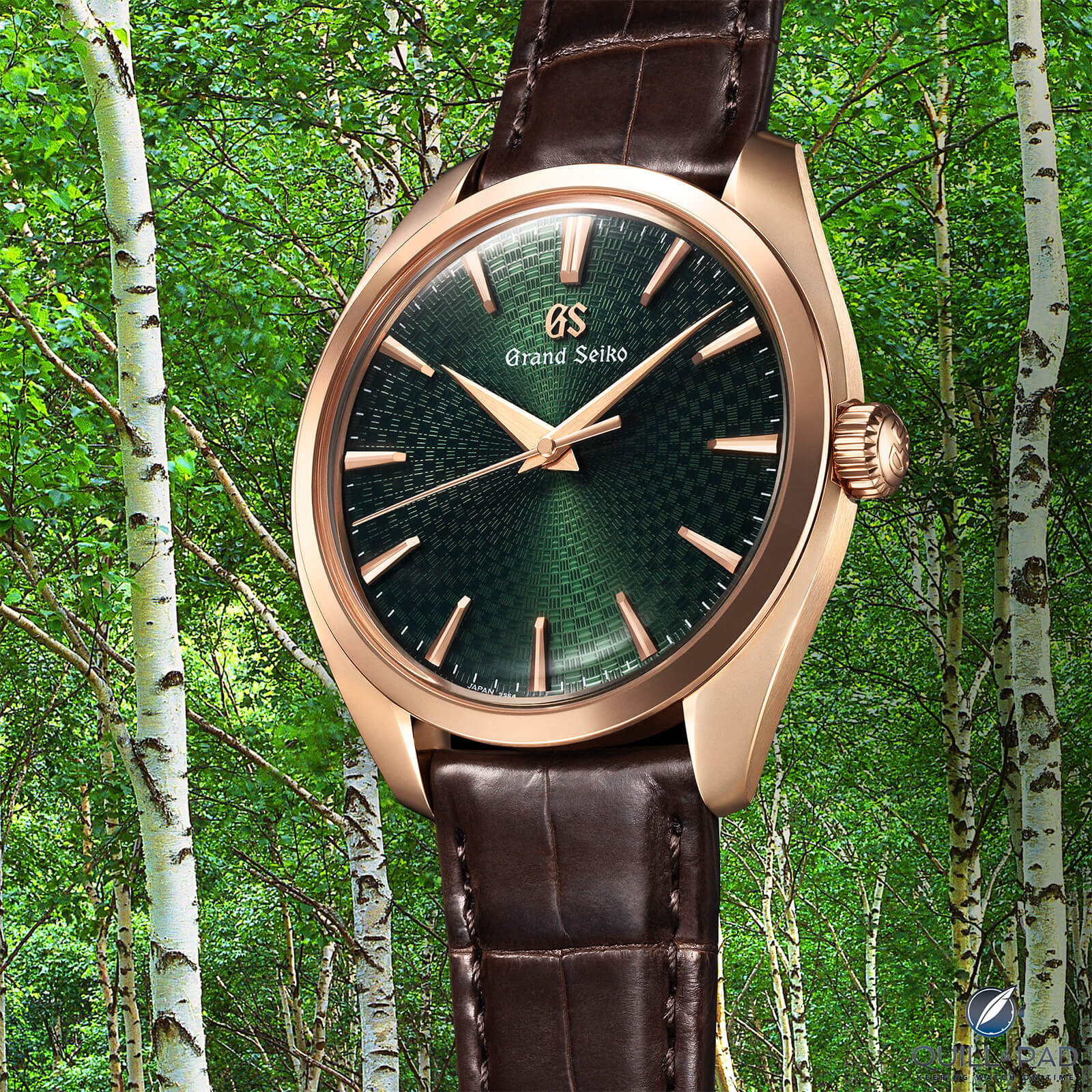
Grand Seiko SBGW264 limited edition
While they both share the same fundamental case design, just in two different metals, the dials and hands are the clear differentiators for this pair of watches. The SBGW264 in pink gold features a delicate forest-green dial that has been machine engraved with a circularly radiating checkerboard-like design; not guilloche but still an incredibly attractive pattern.
The dial also features applied gold hour markers providing excellent contrast against the darker background of the dial. Tiny white pad-printed minute hash marks are found along the outside edge, tying into the printed words “Grand Seiko” below the applied gold GS logo.
It’s a time-only watch featuring hours, minutes, and seconds showing the time with matching gold hands that have been expertly shaped. The green engraved dial is the highlight of this piece and differs dramatically from the SBGW263, which goes an entirely different route.
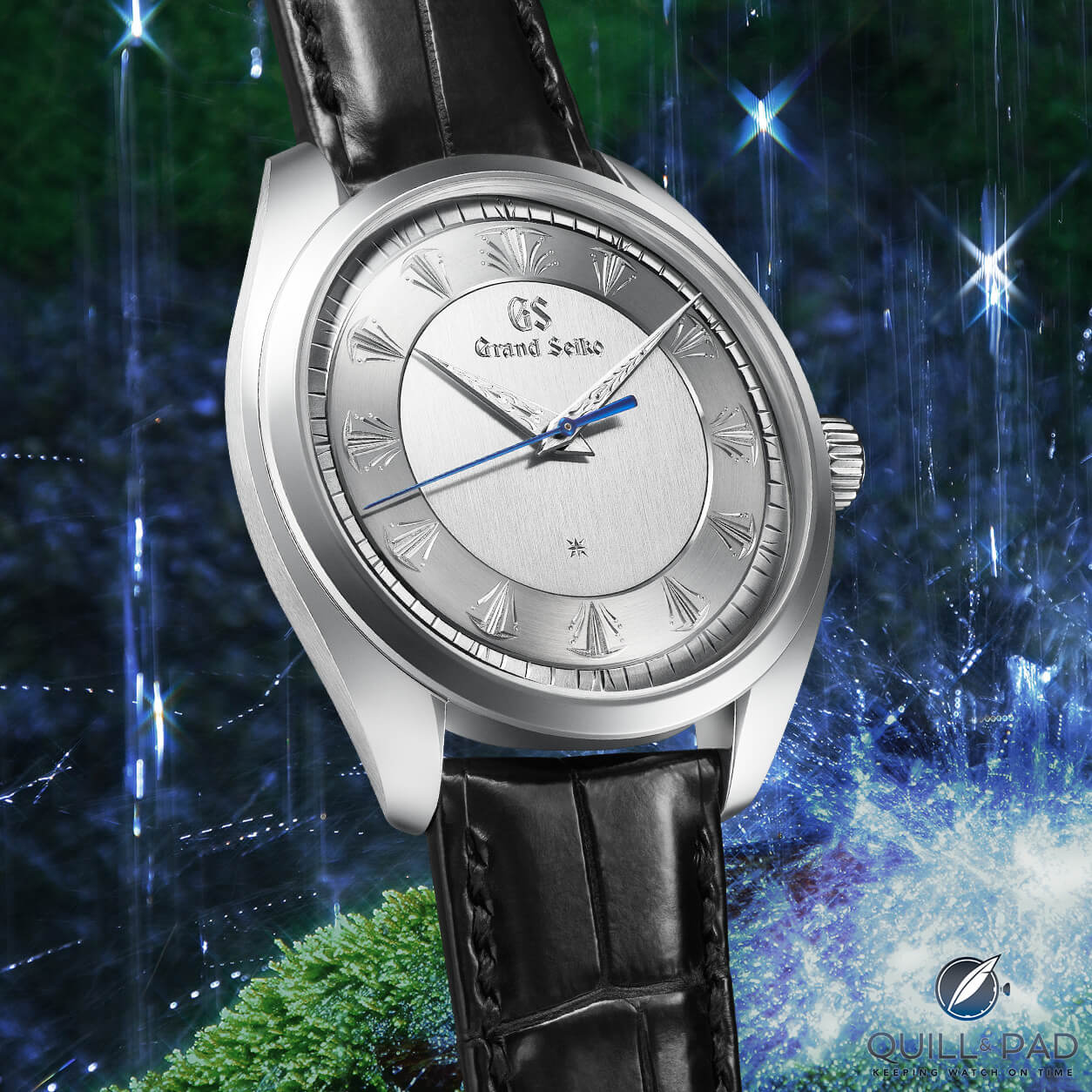
Grand Seiko SBGW263 limited edition
Instead of applied markers and a precise machine-engraved dial, the platinum model boasts a three-part white gold dial, each section hand engraved with a very distinct pattern, which I’ll detail in below.
There is practically no color to this watch aside from the stark blue second hand. Otherwise any contrast or differentiation comes down to finish choices and the sharp cuts of the engravings. It is a solid embodiment of the mysterious Yūgen aesthetic for sure, so let’s dig into that a bit more.
Japanese Yūgen aesthetic principle and more
The platinum SBGW263 is inspired by the location of Grand Seiko’s Shizukuishi manufacture. The name of the town, Shizukuishi, comes from a legend about a deep cave that resonated with the sound of dripping water on the rocks.

A rendering of the brand-new Grand Seiko Shizukuishi Studio in Japan
That legend is artistically depicted via the engravings on the dial and hands. The hour and minute hands portray the water drops, and the engraved hour markers are the splashing drops hitting the rocks. The splash continues on the outer chapter ring where the fives are depicted as splashes as well. Aside from the individual minute marks in between, all of the engravings are directly inspired by the dripping of water onto cave rocks.
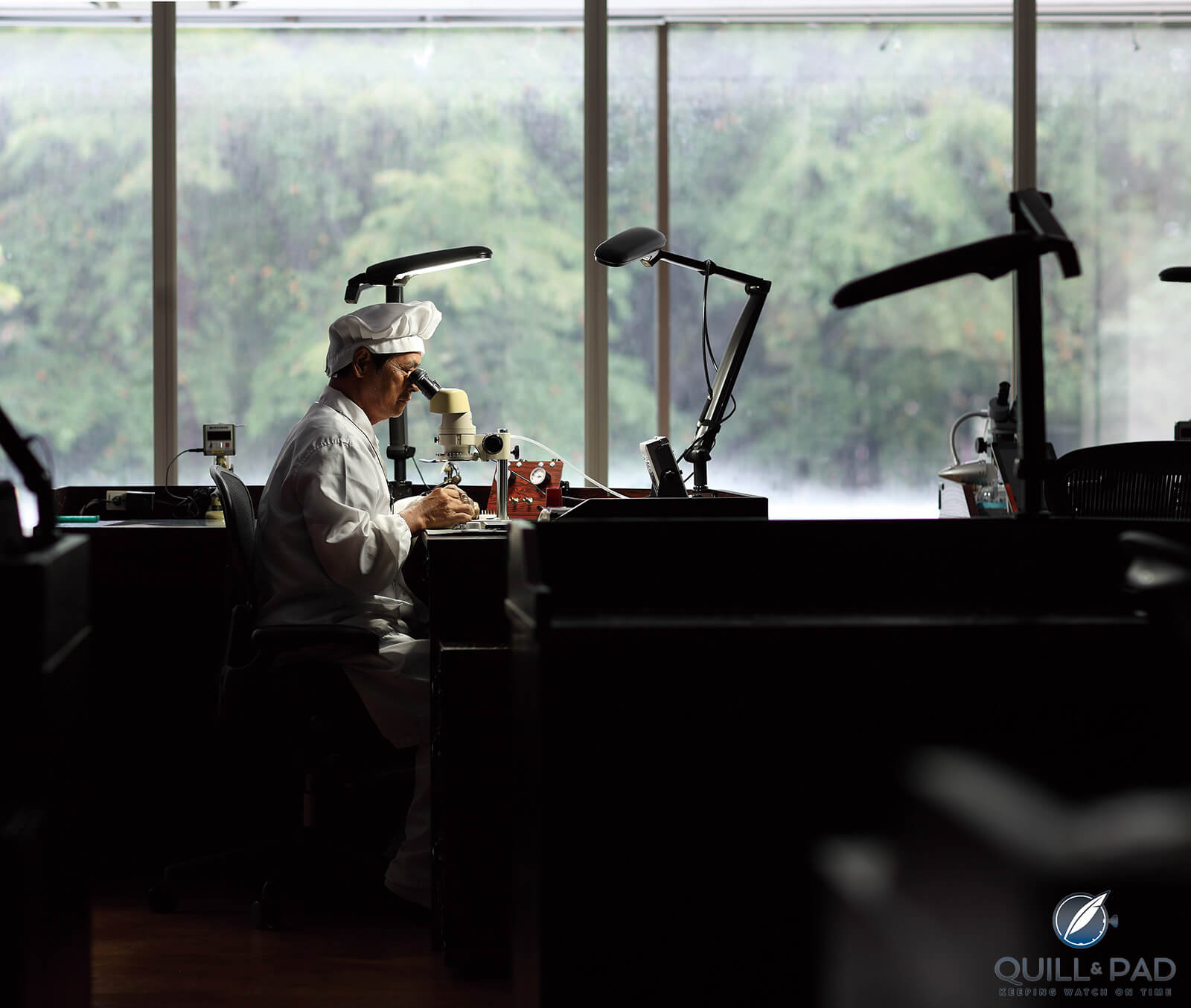
Grand Seiko Shizukuishi workshop in Japan
The Yūgen aesthetic is all about the mysterious beauty of nature, the hidden and unknown, which is what the legend of Shizukuishi is about: an old man searching for the source of a sound only to discover the seemingly bottomless cave and sound of dripping water.
The implementation of that aesthetic also falls under the principles of Miyabi, Shibui, and Geidō due to its elegant simplicity, which highlights the artistic craft of hand engraving. It’s obvious once you know to look for these principles; the details almost call out to you.
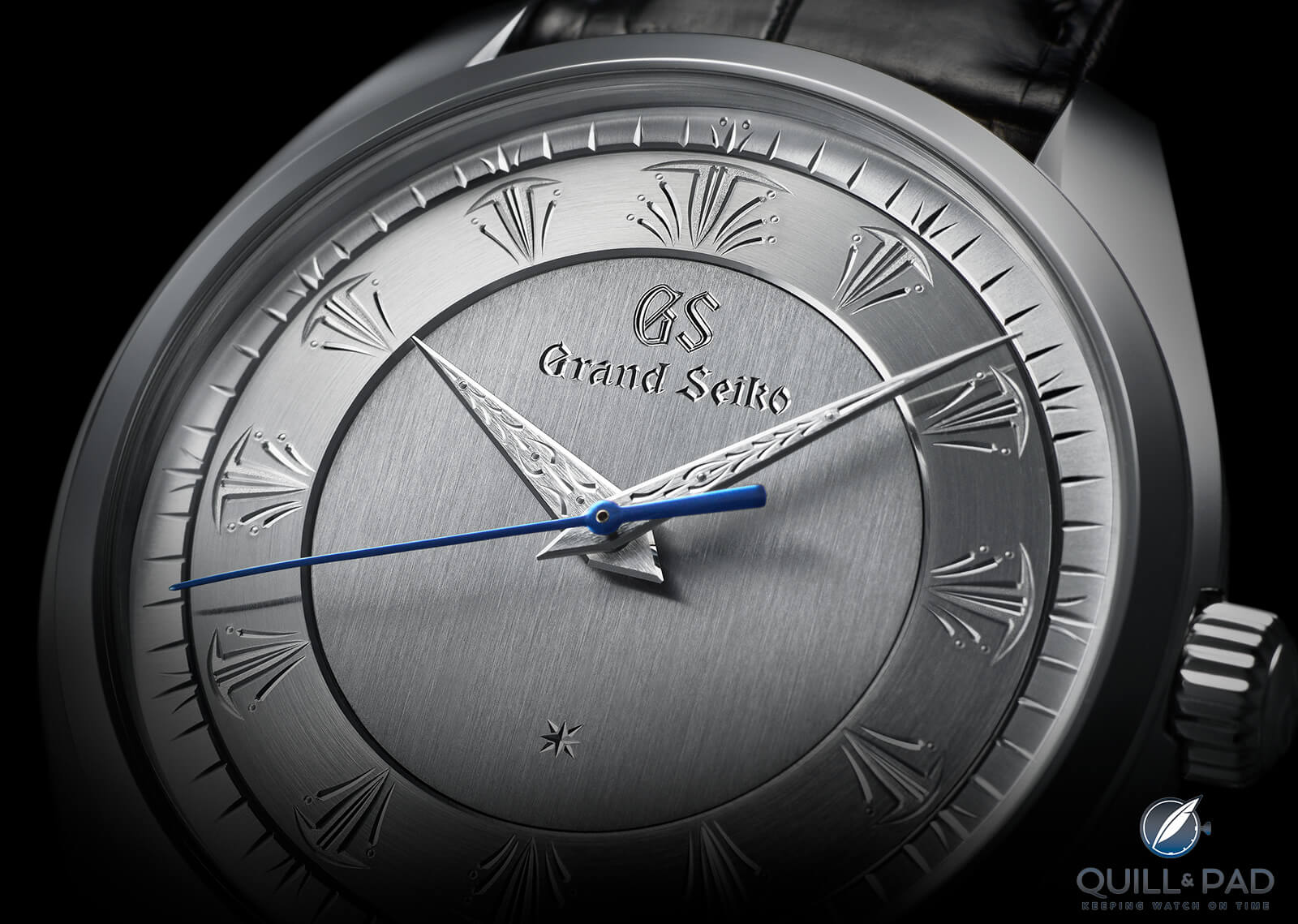
Grand Seiko SBGW263 limited edition dial
The dripping water could also allude to Jo-ha-kyū (movement) and Wabi-sabi (impermanence): it’s all there. What’s more, the principle of Geidō is very evident from the work of master engraver Kiyoshi Terui and his team, who hand engraved all the dial components, including the very detailed GS Grande Seiko logo.
With all the dial components being slightly curved, it truly highlights the persistence and focus on craft necessary to create engravings that look perfect and consistent, probably one of the hardest things to achieve with hand engraving.
But the platinum version of this watch isn’t the only one demonstrating these principles. The SBGW264 in pink gold hits hard with the principles of Miyabi, Shibui, and Jo-ha-kyū. The dial engraving creates a lot of visual movement, and the clean details of the markers and hands pull the simple, refined elegance together for a super clean and intriguing design.
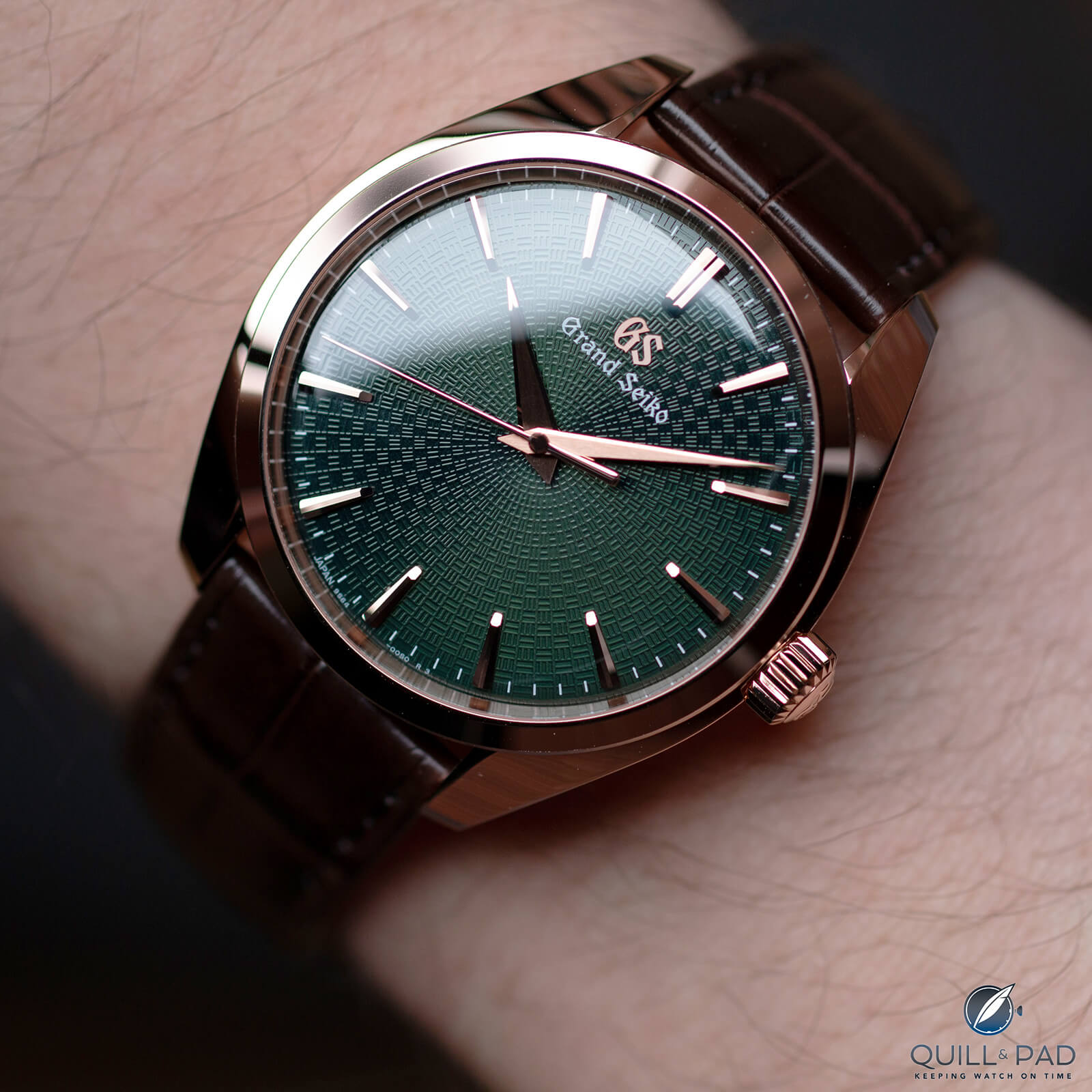
Grand Seiko SBGW264 limited edition
Moreover, the dial details are directly inspired by the local birch forest surrounding Shizukuishi.
The deep green gives way to highlights of almost white when viewed at different angles on the light. This represents the way the light shines on the birch leaves but lets some of the stark white of the birch bark peek through as the leaves flutter in the breeze. That brings the watch full circle back to the Yūgen aesthetic: the mysterious beauty of nature sitting right outside, inspiring the designers throughout their day.
Same core, different approach
Flipping each of these models over, we find that they both go a unique route more in line with the aesthetic principles carried over from the front.
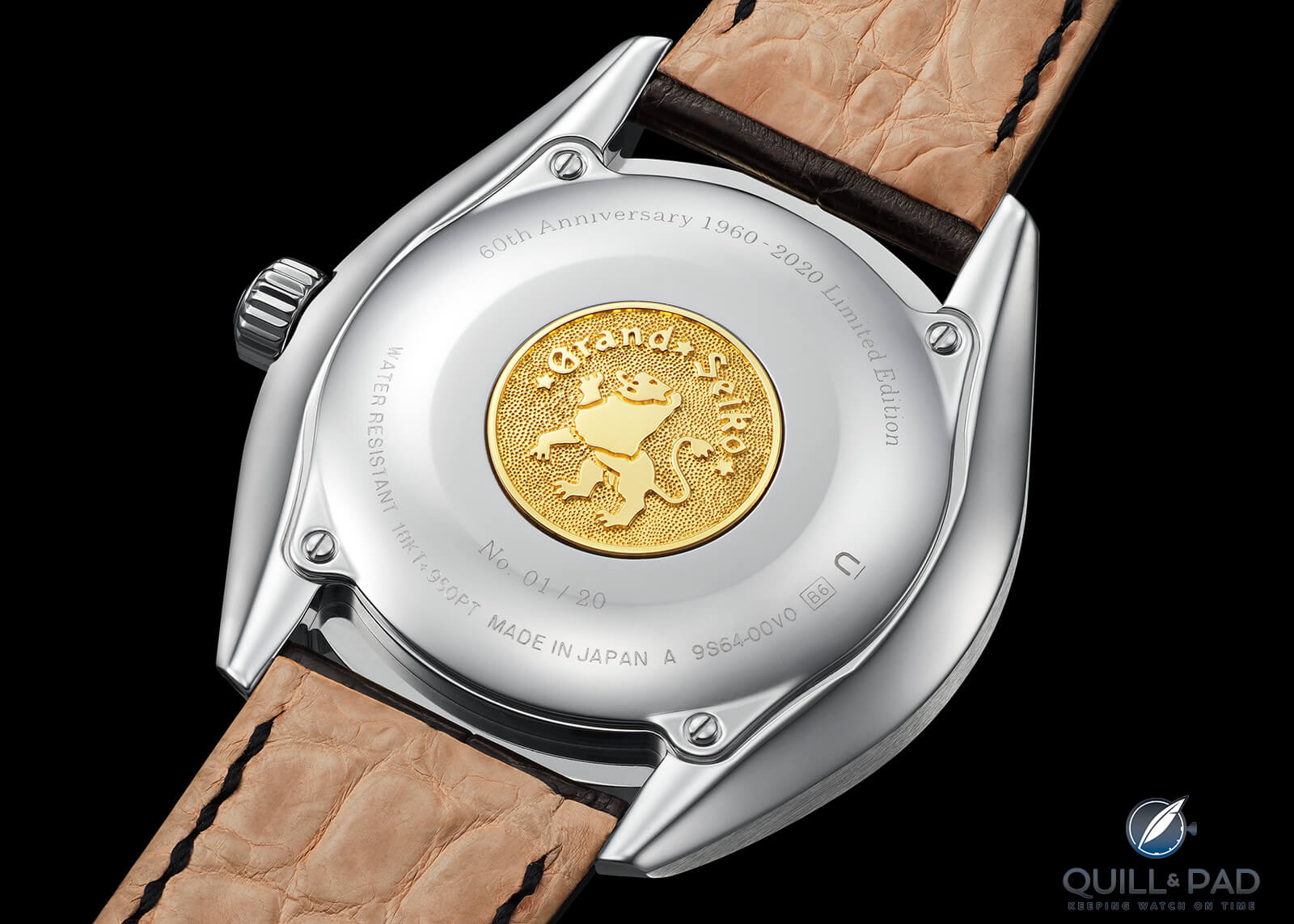
Embossed and engraved case back of the Grand Seiko SBGW263 limited edition
The platinum model has a solid case back with a hand-engraved gold medallion inserted into the center, a high-relief Grand Seiko lion in yellow gold. This focus on the craftsmanship aesthetic makes perfect sense based on the hand-engraved details of the front. It also hides Caliber 9S64, a distinctly modern movement in appearance that contrasts with the subdued handcrafted aesthetic dial side.
The pink gold model continues with the refined elegance angle and instead has a sapphire crystal case back to highlight well finished Caliber 9S64 inside. The finishing of the caliber also falls in line with the Miyabi and Shibui aesthetics, and even more so Ensō, the minimalist Japanese aesthetic.
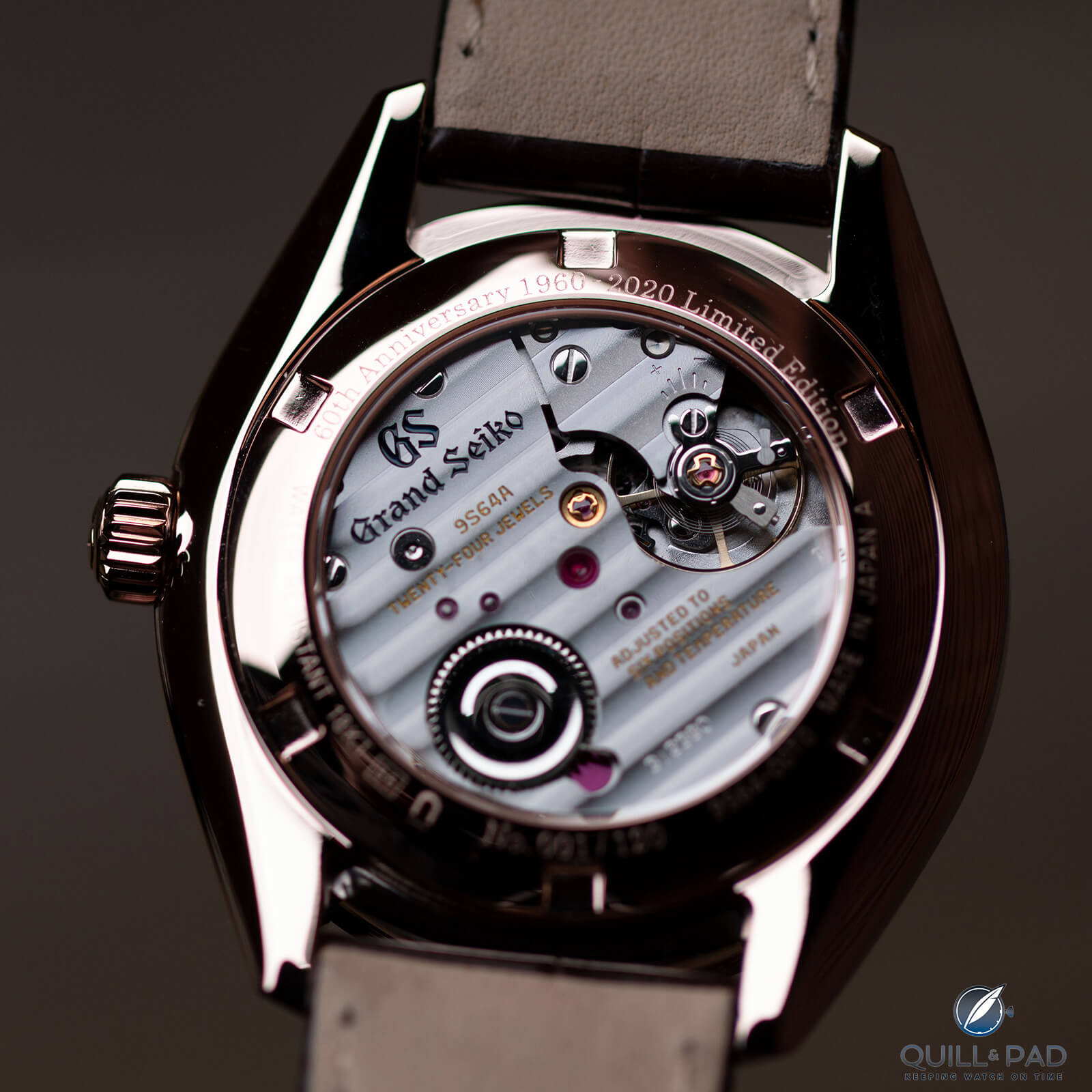
Display back of the Grand Seiko SBGW264 limited edition
It doesn’t seek to be the most elaborately decorated movement with a heaping of beveling, engraving, and various finishes often found on Swiss movements. Instead, it feels straightforward and honest, yet still precise and perfected.
To me this is a great display of how one can start with the same movement and case, go in such different visual directions, and yet still tie the two products so intimately together based on the guiding aesthetic principles.
The aesthetic principle of Ensō seems the most applicable to the entire practice of creating these two watches – and most pieces by Grand Seiko.
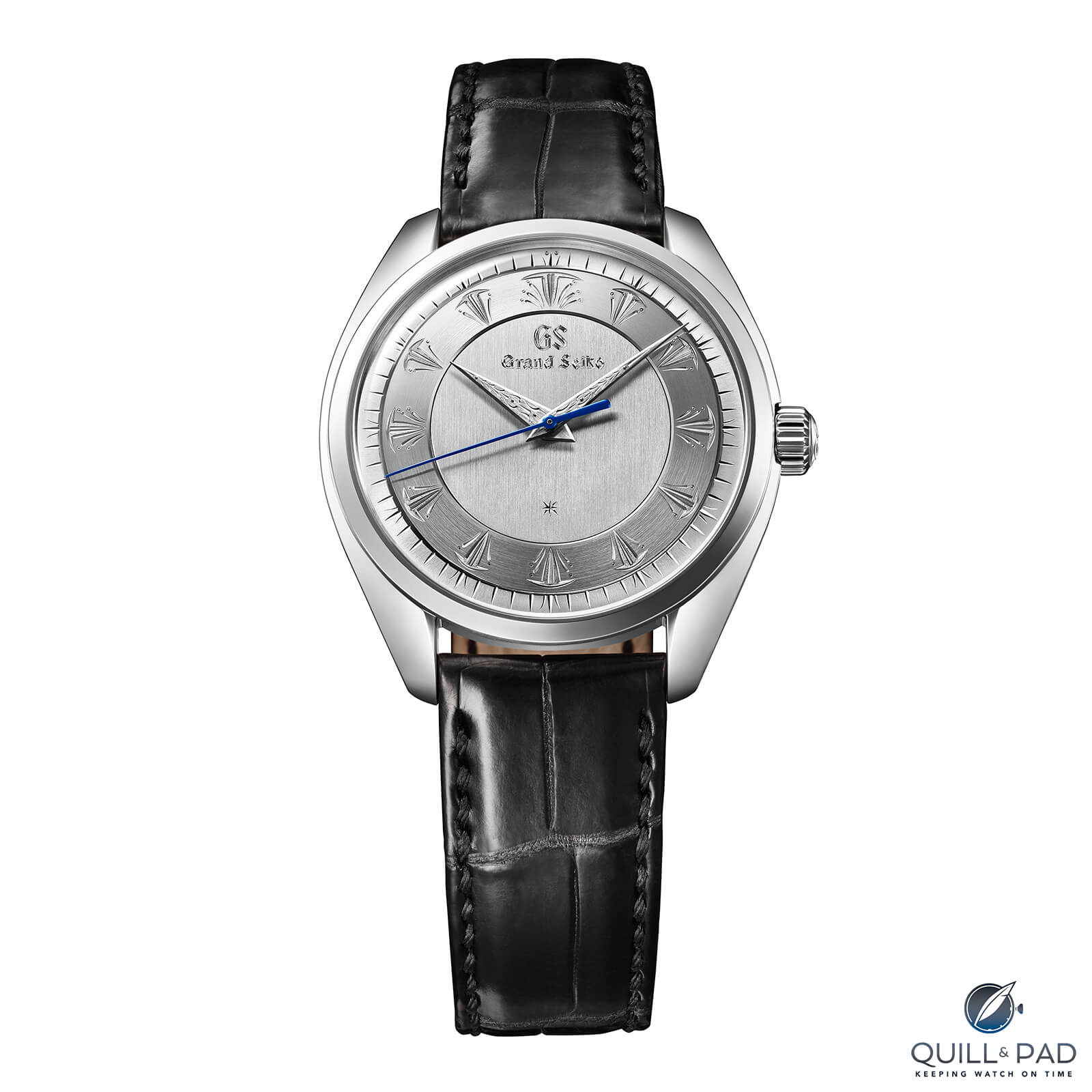
Grand Seiko SBGW263 limited edition
The brand regularly references the “Grande Seiko aesthetic,” which I think can be clearly demonstrated to rest on the eight main principles of the Japanese aesthetic. Sure, it is in different amounts at different times for different models, but there is always the undercurrent of striving for Ensō and its companions.
It is this consistency that helps Grand Seiko make model after model fit snugly within the brand as a whole while also allowing for Iki – creativity and flair – for its designers.
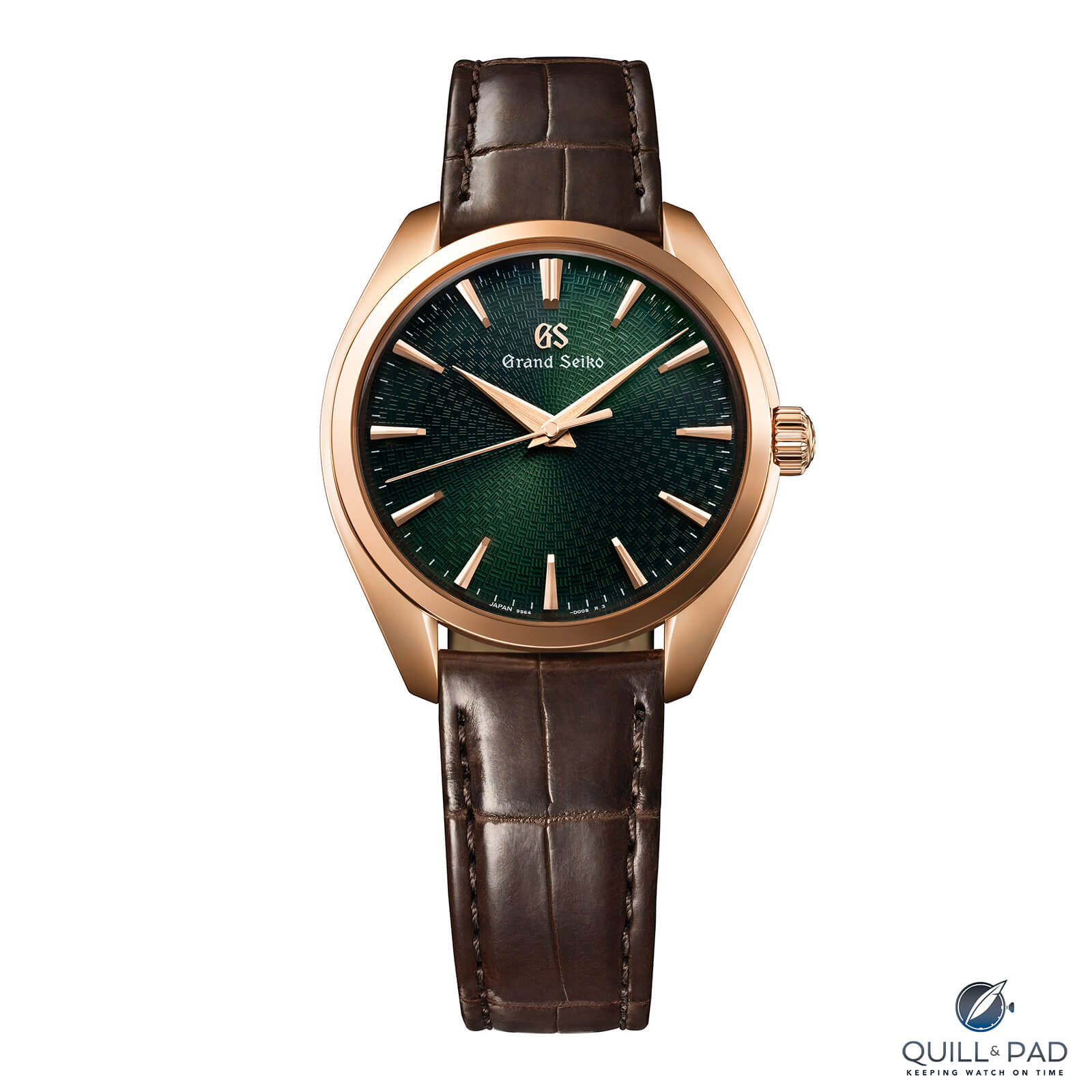
Grand Seiko SBGW264 limited edition
These two limited editions made to celebrate 60 years of the sub-brand are fairly different on the surface, but both achieve similar success of representing the Grand Seiko aesthetic and legacy of the brand. With possibly two very different customers for each watch, Grand Seiko also utilizes guiding principles to speak to both types of collector.
That is something the brand is very successful at, and based on the other releases in honor of the sixtieth anniversary will continue to be in the foreseeable future.
We broke down the aesthetic, now let’s break down both of the watches!
- Wowza Factor * 8.2 The different dials are awesome, and the subtle, refined aesthetics are enough to make this man say wowza!
- Late Night Lust Appeal * 82.22» 806.303m/s2 I’m torn over which one I’m lusting after more, but regardless I’m still lying awake thinking about the duo!
- M.G.R. * 54 A stout hand-winding Grand Seiko caliber is definitely geeky enough for me!
- Added-Functionitis * N/A No surprise here again: it seems that there isn’t much need for anything extra, so I guess no need for Gotta-HAVE-That cream as well!
- Ouch Outline * 9.19 That grinding in your rotator cuff! Being a pitcher in high school baseball without a pitching coach leads to problems later in life – like a painful grinding in your shoulder while doing basic exercises like pushups. Oh well, it’s too late to tell my teen self to take it easy, but I’ll still gladly accept that bit of pain if it means getting one of these on my wrist!
- Mermaid Moment * The slow burn of a couple weeks! The beauty of Grand Seiko is that the subtle refinement produces a lot of fantastic watches that don’t scream “Hey, look at me!” but instead whisper, “You know you want to come over to my place later . . . !”
- Awesome Total * 828 First take the platinum case alloy (950) and add the gold case alloy (18), then subtract the total number of pieces in the limited editions combined (140) to get an aesthetically awesome total!
For more information, please visit www.grand-seiko.com/us-en/special/60th/shizukuishi-engraving.
Quick Facts Grand Seiko SBGW263
Case: 39 x 11.8 mm, platinum and 18-karat yellow gold
Movement: manual winding Caliber 9S64, 72-hour power reserve, 28,800 vph/4 Hz frequency
Functions: hours, minutes, seconds
Limitation: 20 pieces
Price: $97,000
Quick Facts Grand Seiko SBGW264
Case: 39 x 11.6 mm, 18-karat pink gold
Movement: manual winding Caliber 9S64, 72-hour power reserve, 28,800 vph/4 Hz frequency
Functions: hours, minutes, seconds
Limitation: 120 pieces
Price: $24,000
*This article was first published on September 6, 2020 at Grand Seiko Elegance SBGW263 And SBGW264: Using The Principles Of Japanese Aesthetics.
You may also enjoy:
Grand Seiko 1960 Re-Creations: Celebrating A Turning Point
Why I Bought It (Despite The Strap And Buckle): Grand Seiko Blue Snowflake Reference SBGA407
Grand Seiko’s Urushi Dials Give The Elegance Collection A Competitive Edge (And Eye Candy)
Visiting Seiko’s Haute Horlogerie Micro Artist Division
Grand Seiko Spring Drive Chronograph GMT SBGC203: You Can Have It All
Leave a Reply
Want to join the discussion?Feel free to contribute!





















































What a truly great article. The description of Japanese aesthetics seemed great. I say “seemed” because these concepts are tricky to articulate accurately, the accurate translation of nuanced Japanese philosophy and aesthetics is hard to pull off. But you seem to have done it justice.